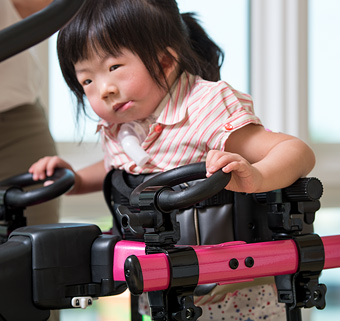Pacer Gait Trainer Prompt Reduction
| May 2011A Call for Video Submissions
All of us are trying to reduce something in our lives—whether it is our waistline, trash output, or stress level. But taking away support prompts on a Pacer gait trainer – that is true reduction and positive steps to increased ambulatory independence for people with disabilities. Prompts provide guidance and support where the body is not physically able. Through intense supported over-ground gait practice, individuals can gain enough strength, balance, or ROM to progress, replacing the supports with independence and active participation.
At Rifton.com we’ve tried to encapsulate what prompt reduction looks like. Last month we posted a Pacer Prompt Reduction article. But we would love to collect and share how others are successfully reducing prompts.
Below are links to a few sequential clips we’ve found of three different children as they progress with their ambulation skills using the Pacer gait trainer. Do you have other video clips that show this more clearly? Or are you aware of other clips already on Youtube? Let us know.
Here’s a sampling of the raw amateur clips we’ve found so far:
Peyton
1) Peyton walking some more…. (Peyton walking in Pacer with lots of support prompts)
2) Peyton walking with no seat support (Hip positioner has been removed)
3) Peyton walking around the house. Feb 2010! (Using a basic walker with no prompts)
4) Peyton walking even more…. (Now she can walk and run outdoors on uneven ground)
Noah
1) Noah in his gait trainer (He has lots of supports, just starting to learn)
2) Noah WALKING with his walker June (spina bifida) (He has progressed to a basic walker)
3) Noah walking unassisted! Thu, Nov 25 (Through prompt reduction, he can now walk independently without any support!)
Makenzie
1) Look at my new trick (Here is Makenzie using the Pacer gait trainer to learn to walk)
2) Look at me Walk (Now she can walk without a walker!)




